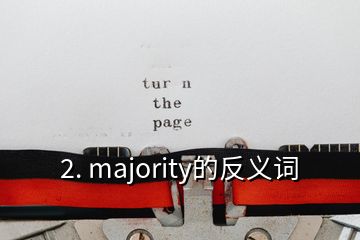1. majority

答案是,用單數形式還正確哦
2. majority的反義詞

成人的英語單詞是adult。;adult 英 ['?d?lt] 美 ['?d?lt] ;n. 成年人;成年動物;adj. 成年的;理智的;適合成年人的;成熟的;1、adult用作形容詞的基本意思是“成熟的”,指人身體已經發育成熟,也可指智力及情感已成熟,用于物則指達到發展過程中的成熟階段。;2、adult也可作“成年人的,適宜于成年人的”解,指已經度過青春期或已經達到法定年齡。;3、adult作“成年的”“成年人的”解時不用于比較等級,作“老成的”解時可用于比較等級。;擴展資料;反義詞:immature、childish;一、immature 英 [??m?'tj??(r)] 美 [??m?'t??r] ;adj. 不成熟的;例:Sows are immature for the majority of their breeding life.;母豬在它大部分繁殖過程是不成熟的。;二、childish 英 ['t?a?ld??] 美 ['t?a?ld??] ;adj. 孩子氣的;幼稚的;例:She clapped her hands in childish glee.;她孩子氣地高興地拍著手。
3. majority翻譯
立黨為公 [詞典] The Party is founded for public interests.; build a party for the interests of the vast majority; build a party serving the interests of the people; [例句]一是著力增強宗旨觀念,切實做到立黨為公、執政為民。
First, increasing the awareness of the Party's principle and working hard for the people.
4. majority的讀音
the majority of+復數名詞用作主語時,謂動用復數;the majority of+不可數名詞用作主語時,謂動用單數。
一、the majority of釋義大多數。
二、the majority of讀音英 [e? m??d??r?ti ?v],美 [e? m??d???r?ti ?v]。
三、the majority of示例:The majority of foreign nationals working here have work permits.大多數在這里工作的外國人都有工作許可證。
5. majority的形容詞英文
majority詞根詞綴快速聯想法
詞根:-magn-→maj大的+中綴-or形容詞詞尾+后綴-ity名詞詞尾
n.大部分;大多數;(獲勝的)票數;多數票;超出其余各方票數總和的票數;
例句
This treatment is not available in the vast majority of hospitals.
絕大部分醫院都不提供這種治療。
6. majority后面的謂語動詞
the majority of people作主語時,謂語動詞用單數、復數都可以. the majority of + 名詞作主語時,強調整體時,使用單數動詞;若強調團體中的每一個分子
7. majority of
majority的基本意思是“多數”“大多數”,尤指在選舉中在半數以上,即超過其余候選人得票總和的人或政黨,也可指票數差距,即多得的票數或超過的票數。
majority也可泛指“大多數”。
majority還可作“成年人”解,指達到可以投票的法定年齡,如英國、中國等為18歲。
majority單獨用作主語時,謂語動詞多用單數形式,在強調“多數中的各個成員”時,謂語動詞常用復數形式。
majority只用作單數,通常與of連用。the majority of后可用單數名詞,也可用復數名詞,謂語動詞的數與of后面的名詞相一致。
當把“多數”當作一個整體和少數人的整體相對比時,謂語動詞用單數形式。
8. majority的用法
the majority of 這種是固定的短語,還有一些比如 most of , a lot of ,a large number of 等等表示數量,a large chunk of ice(一大塊冰)類似這種表示數量大小形狀的of短語 這些都順著翻譯。
其余反之。
9. majority的形容詞和名詞
a majority of 是大比數,必須有大概的總數和要做出比例比較
a number of 是數個,并沒有具體的數目也沒有比例比較
a pool of 是一群,同樣沒有具體的數目也沒有比例比較;a pool of 和a number of 相比 a pool of 的數量要多
a number of…
a number of…意思是“一些,若干”(= some),后接可數名詞復數或代詞,謂語動詞用復數形式。
a number of…詞組中還可以加入形容詞表示數量大或小等(例如:a large/small number of…許多/少數……)。
注意和the number of的區別。the number of…意思是“……的數字/數目”,介詞of同其后名詞構成介詞短語,修飾the number.當它作主語時,謂語動詞用單數。例如:
Many people took part in 10,000-metre race, but only a number of them kept on running to the end. 許多人參加了10000米跑,但只有一些人堅持跑到底。
A number of my friends think I should take a holiday.
我的一些朋友認為我應該休假。
The number of students is about twenty.
學生人數大約是20人左右。
10. majority做主語謂語動詞如何處理
分情況,有時單數有時復數。
1. the majority表示“大多數”時,是集合名詞;若單獨用作主語,謂語動詞可用單數(若強調整體)或復數(若強調個體)。如:
The majority has [have] seen the film. 多數人看過這部電影。
But the majority were [was] on Ben’s side. 但多數人都站在貝恩一邊。
但是若單獨用的 the majority后跟有復數表語,則謂語通常要用復數。如:
The majority are young people. 大多數是年輕人。
2. “the majority of+復數名詞”用作主語時,謂語動詞通常用復數,偶爾也可以用單數。如:
The majority of them are professional drivers. 他們大多是職業司機。
The majority of criminals are non-violent. 大多數罪犯是不使用暴力的。
The majority of students were [was] indifferent to the political meeting. 大多數學生對政治集會漠不關心。
3. “the majority of+集合名詞”用作主語時,謂語動詞可用單數(視為整體)或復數(考慮其個體)。如:
The vast majority of the population lives [live] in utter misery. 這里的絕大多數人生活在極度貧困之中。
4. “the majority of+不可數名詞”用作主語時,謂語動詞總是用單數。如:
The majority of the work has been finished. 大部分工作已完成。
The majority of the damage is easy to repair. 這次的損害大部分容易補救。
注:按傳統語法,the majority of只用于修飾可數名詞復數或具有復數意義的集合名詞,但在現代英語中它也可用于修飾不可數名詞。
5. “a majority of+復數名詞”用作主語時,謂語動詞通常用復數。如:
A majority of visitors have arrived. 大多數參觀者已經到了。
A clear majority of voters were in favour of the motion. 絕大多數選民贊成這一動議。
11. majority的用法與搭配
一、英語中連字符組成的復合詞:
1.形容詞+名詞:如long-distance telephone(長途電話), old-style machine(舊式機器)。
2.名詞+v-ing:如peace-loving people(熱愛和平的人民)。
3.名詞+過去分詞:如hand-made goods(手工制品),man-made lake(人工湖泊)。
4.副詞+過去分詞:如highly-developed industry(高度發達的工業)。 5.副詞+v-ing:如hard-working people勤勞的人民。
6.名詞+名詞:如coal-mine(煤礦),wave-length(波長)。
7.形容詞+名詞-ed:如 old-fashioned machine(老式機器),cold-blooded animals(冷血動物)
8.名詞+形容詞:如snow-white paper(雪白的紙)。
9.形容詞+v-ing(或過去分詞):如funny-looking man(相貌可笑的人),clear-cut answer(明確的回答)。
10.形容詞+形容詞:如dark-blue ink(深藍色的墨水)。
二、連字符常被用于作為定語的一個單元修飾語之間,以避免誤解。
例:
Mr. Green was a small-business man.
格林先生是位做小買賣的商人。
Mr. Green was a small business man.
格林先生是一個身材矮小的商人。
三、位于名詞之前用作定語的復合修飾語之間,一般應加連字符。
例:
Jim is a 15-year-old boy.
吉姆是一個十五的男孩。
Lily is a well-dressed woman.
莉莉是一個衣著漂亮的女人。
四、通常在self-,ex-,half-,quarter-,all-作為詞綴的復合詞各部分之間應加連字符。
self-control(自制),self-respect(自尊心),ex-president(前總統),half-asleep(半睡的),quarter-share(四分之一部分),all-round(多才多藝的)。
五、連字符可用來連接由一個單一的大寫字母和一個名詞或分詞構成的復合詞。
an X-ray photograph(一張X光照片) V-shaped thing(V形物)。
六、連字符可用來連接21—99的復合數詞。
thirty-nine(39),fifty-one(51),eighty-eight(88)
七、連字符可用在書寫分數的分子和分母之間,特別是在當這一分數用作修飾語時。
a three-fourths majority(占四分之三的大多數)。
八、當連字符用在數詞之間或日期時,它有“到”和“包括”的含義。
pages 12-56(從第十二頁到第五十六頁)。
九、連字符可用于某些前綴分詞與詞根之間。
vice-chairman(副主席)。
十、連字符可用于臨時性的復合詞的單詞之間。
Good-for-nothing material
向左轉|向右轉
擴展資料
連字符和破折號的區別:
連字符(hyphen)與破折號(dash)是不一樣的。破折號有兩種形式:en dash和em dash。前者是指如字母n一般寬,比連字符長但短于em破折號。
En破折號用來表示數量范圍,用來替代諸如to或and這樣功用的單詞,例如an east-west route。它還用于多種形式的組合行為,例如a US-Canada negotiation、the mind-body problem。
Em破折號長度是一個字母m,功用近似圓括號或冒號—用以表示中斷、事后添加或詳盡闡述—但是,圓括號就像是對讀者的輕柔耳語,而em破折號像是揮手吸引人們注意力。
Em破折號還可以連用兩個,表示一個句子結束時語法性的省略或遺漏了字母。我們通常在對話中能看到這種情況。
例如:“I think he had better——,”這里的兩個em破折號表示句子是不會完成的,或是在這樣的書面例子中 “I refer now to the testimony of Mr. F——.”